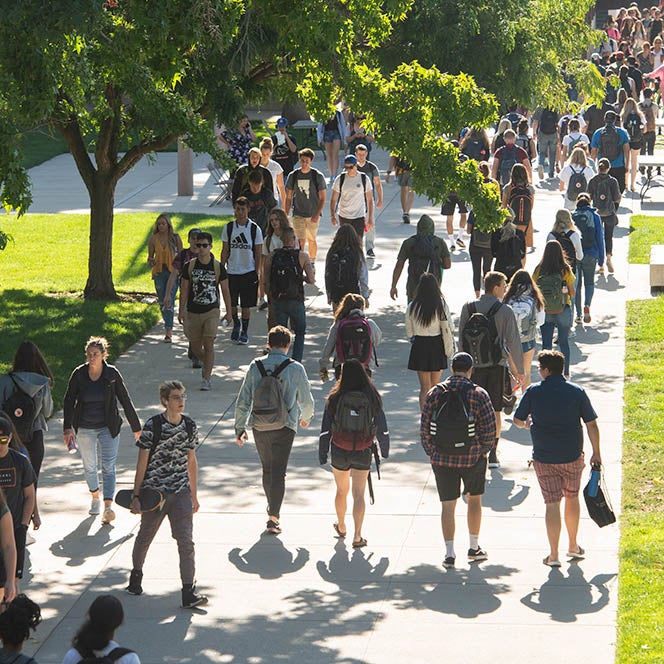
The first day of class presents faculty with an opportunity to create a sense of belonging, foster student excitement, and offer insights into skills and knowledge students will cultivate throughout the semester (Lang 2019). Icebreaker activities welcome students into a shared learning space and should reflect the cultural values of the students. Additionally, these activities mimic the role of short discussions with other students that set the expectation for semester-long engagement. This page explains two activities that emphasize behavioral engagement (a student’s level of participation in activities and conversation) and emotional engagement (the emotional reaction to learning and to other people in the learning space) (Lei et. all 2018) to start building a welcoming environment.
Wagon Wheel
Ask students to form two concentric circles. The students forming the inside circle face outward, while the students forming the outside circle face inward. One inside circle student should face one outside student. Next, ask students to spend sixty–ninety seconds answering a question. After time ends, ask students in the outside circle to rotate one person to the left while the students on the inside circle remain stationary. Repeat. Ask questions that aim to foster community by helping students identify commonalities and generate intrigue between students. For example, ask questions such as “People often ask me for help with ……,” “If money was not an issue, I would spend my time doing this …..” The activity asks students to talk to different classmates and encourages students to find touchstones of commonality that can generate relationships of trust in a classroom. Inside-Out Prison Exchange instructors facilitate Wagon Wheel on the first day of class (Heider 2018), and faculty can easily modify this activity for different learning environments in collegiate classrooms.
Mix and Match
Ask students to sort themselves by categories, typically by standing and then moving to different parts of the room. Sorting categories can include alphabetical order by first or last name and then delineate at certain letters (i.e. A–C, D–I, etc.), where students consider “home” (i.e. states, regions, countries, etc.), height, number of siblings, etc. Aim to help students create groups based on simple commonalities. Form groups that encourage students to talk to each other without getting overwhelmed with too many voices in any one group. Once the groups form, task students with introducing themselves and then discussing a question or topic (3-5 minutes). Some questions should pertain to the specific class topic (i.e. In biology, you might ask, “What is your favorite organism and why?”) to more general questions (i.e. “If you could travel anywhere where would it be and why?”) After small group discussions, ask students to sort again by a different category, followed by a different discussion question. Repeat as time allows, trying to group different students together. This activity asks students to move around the room and talk to different classmates to form connections with other students. Since students move around, they experience different views of the classroom which may help them decide where they would like to sit and who they want to sit nearby. Additionally, in first-year courses or general education courses, the activity quickly shows points of commonalities between students who may not know anyone, enabling them to identify potential friends.
First-Day Survey
Create a survey to collect information about your students’ learning goals, learning preferences, personal information, and prior knowledge. In a recent Insight Higher Ed article, Ashley Mowreader encourages faculty to get to know their students right from the start and take an interest in students’ aspirations and learning circumstances. You can administer the survey via a paper handout, in Canvas, or a different online platform such as Google Forms. Depending on the questions you formulate, the survey can help you gather information on how prepared your students are coming into this course (prior knowledge), their learning preferences (auditory, visual, social, verbal, etc.), how to connect the course learning outcomes to students’ goals and get to know your students (e.g., preferred names, how many credits they are taking, if they have full-time jobs also). The first-day survey supports belonging and creates community. You can share an anonymous analysis of the survey results the next class, reach out to individual students, and keep the results as important information when planning your class sessions.
For other first day of class ideas, please check out this list of Fabulous First Day Activities collected by the Boise State Center for Teaching and Learning. We encourage faculty to adapt these activities in ways that best reflect the pedagogical goals of their classes (and their teaching styles) as they create environments where students can thrive.
Works Cited
Hao Le, Yunhuo Cui, and Wenye Zhou. “Relationships between Student Engagement and Academic Achievement: A Meta-Analysis.” Social Behavior & Personality: An International Journal 46, no. 3 (March 2018): 517–28. doi:10.2224/sbp.7054.
Heider, Carmen. “The Inside-Out Prison Exchange Program: Intersections between Feminism and Communication.” Humanities 7.3 (2018): 1–13. https://doi.org/10.3390/h7030084
Lang, J.M. “How to teach a good first day of class advice guide.” Chronicle of Higher Education, January 4, 2019, https://www.chronicle.com/article/how-to-teach-a-good-first-day-of-class/, accessed July 7, 2022.
Recommended
Harrington, Christine. Keeping Us Engaged: Student Perspectives (and Research-Based Strategies) on What Works and Why. Sterling, VA: Stylus Publishing, 2021.
Adapted from:
Drs. Meg Steinweg (Assoc. Professor, Biology) and Melanie Trexler (Assoc. Professor, Religion), Roanoke College Teaching Collaborative Directors